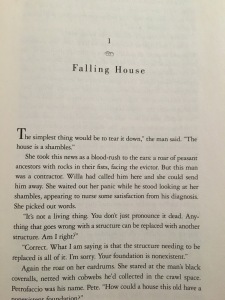 |
| Image: https://marialuisaaliotta.wordpress.com |
Over the summer break I pack in as much reading for pleasure as I possibly can. This objective is in no small part a mechanism for disengaging from work and for propelling my brain into other worlds. This summer I read Barbara Kingsolver’s new book ‘Unsheltered’. I really enjoyed it. But here I want to talk about coherence devices she used which I think have relevance for doctoral thesis writing.
Barbara Kingsolver’s story is set in two time periods: 1871 and 2016, with chapters that take it in turns to develop two separate stories with different characters and events. The devices she uses for connecting these different worlds and times are clever and illuminating—and essential for avoiding confusion. At the beginning the reader (or at least this reader) was mildly unsettled; the first chapter is neat and self-contained, but then into chapter two I found myself checking to see if I’d missed anything—what was I reading now? How did this connect to what I’d just read? Were the chapters to remain two parallel tales or would they come together, and how? Such an intriguing way to draw in the leisurely reader. I had many questions, but I had to suspend my curiosity and just keep on reading. I didn’t mind, I had all the time in the world–and I was already hooked in. I knew she was a good writer and my patience would be rewarded.
But would this work for a doctoral thesis? Unlike Barbara’s novel, the thesis is written for an examiner who is time-poor and who brings a clear set of expectations regarding not only the content, but also the style and form. Their purpose is to mark this manuscript against a set of criteria, and usually within a short timeframe. Nevertheless, while an examiner may not be reading for pleasure in the way I approached the novel, neither do they want to be bored to death! A little bit of suspense, of interest and difference can win over a weary examiner—but not too much; after all a thesis isn’t a detective story or a murder mystery. But, returning to the Kingsolver’s novel …
Connective devices include both content and form
In ‘Unsheltered’ the physical setting—the house and suburb—was the same for both sets of stories. Populated with unrelated people and instances, the parallel stories shared common themes (connection to place, courage and resilience). Similarly, in thesis writing, despite the different foci of each chapter, the parts of the thesis all need to connect to the main project, argument and/ purpose. But I mostly want to talk about the literary devices used to connect the chapters.
Chapter headings
I began to realise that Kingsolver’s chapter headings were subtle and yet powerful messages about the focus of the chapter, and that they played a role in sustaining the story and bridging the eras. Chapter headings were carefully chosen to signal content and/or theme.
 Connecting headings and content
Connecting headings and contentSecondly, the first sentence of each chapter spoke to the title of the chapter in some way. For example, Chapter 1 is titled ‘Falling House’ and the first sentence reads: ‘The simplest thing would be to tear it down,’ the man said. ‘The house is a shambles.’ This pattern is repeated cleverly and subtly throughout.
Connecting chapters
The really neat thing about this book is the way that Barbara Kingsolver connected each chapter to the following by ‘topping and tailing’. The final sentence in each chapter contains a word or phrase which becomes the title of the next chapter. For example, Chapter 4 ‘Scylla and Charybdis’ finishes thus: ‘Thatcher closed the door behind him and felt like Odysseus as he stepped between the two beasts, drawing up the mantle of his worries, turning homeward, striking out.’ The title of Chapter 5 is ‘Striking out’. It is a beautiful device.
 I’m sure other readers would have been as delighted as I was to discover this delicate and unobtrusive—and yet highly effective–set of devices.
I’m sure other readers would have been as delighted as I was to discover this delicate and unobtrusive—and yet highly effective–set of devices.So, what are the lessons for doctoral writers?
Firstly, remember what you do as a writer must match the purpose. You are writing a thesis, not a novel (unless you are!) so be aware of the norms and practices common to your discipline and research approach. If you want to stretch those expectations, do so carefully and with guidance from your supervisor.
You can play within the boundaries of most expectations by harnessing subtle and clever devices such as these. I guess I’m encouraging a mindful approach to our reading, so that whenever we find ourselves lost in a well-told story, we take a moment to consider what we can take into our own writing to make it more engaging.
However, beware: what you cannot risk is being too clever and/or obscure so that the examiner isn’t delighted, just lost and annoyed!
Good luck – and feel free to share your favourite writing devices.
Reference
Barbara Kingsolver (2018). Unsheltered. Faber: London ISBN 978–0–571–34701–8
No comments:
Post a Comment